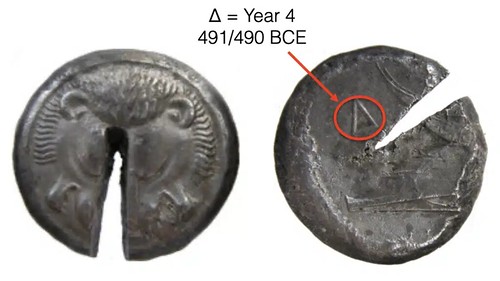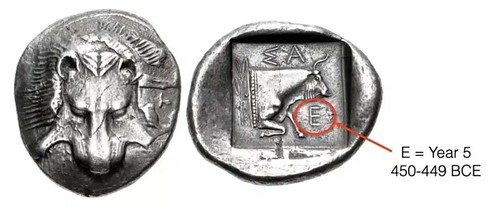
PREV ARTICLE
NEXT ARTICLE
FULL ISSUE
PREV FULL ISSUE
DATES ON ANCIENT COINSMike Markowitz published a nice CoinWeek article about dates on ancient coins. Here's an excerpt - see the complete article online. -Editor
DATES ARE SO universal on modern coins that it may come as a shock to learn that most ancient coins provide no indication of when they were minted. The Zankle Silver Tetradrachm, Zancle 491/490 BCE 17.072 g, 23.5 mm. Asyut hoard. Chisel cut. Image: American Numismatic Society.
The earliest coins to bear a year date were a brief experiment – lasting just six years – by Greek refugees from the Aegean island of Samos who fled the Persian occupation of their homeland to settle at Zankle (today Messina, Sicily) in 494 BCE. On coins they struck, they dated their arrival as Samos Samos. Circa 453/2-440/39 BC. Silver Tetradrachm (24mm, 13.09 g,). SNG Copenhagen 1681. Classical Numismatic Group. Auction 117. 19 May 2021. Lot: 224. Realized: $8,000 Back on Samos a few decades later, this experiment was repeated. From 454 to 440 BCE, silver tetradrachms of Samos were dated with a sequence of Greek alphabetic numerals. The date letter appears on the reverse, below the chin of a bull. A rare example with a date from Year 5 brought $8,000 USD in a 2021 U.S. auction. The experiment was abandoned in 439 when Samos was defeated in a short war by Athens.
To read the complete article, see:
Wayne Homren, Editor The Numismatic Bibliomania Society is a non-profit organization promoting numismatic literature. See our web site at coinbooks.org. To submit items for publication in The E-Sylum, write to the Editor at this address: whomren@gmail.com To subscribe go to: https://my.binhost.com/lists/listinfo/esylum All Rights Reserved. NBS Home Page Contact the NBS webmaster 
|


